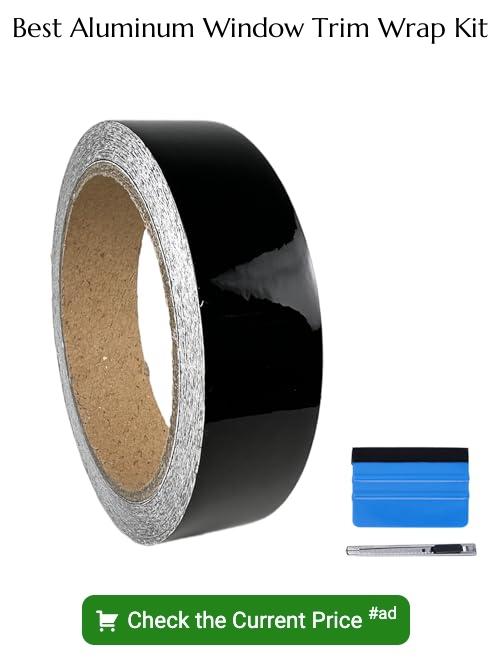This tutorial articulates the step-by-step process of wrapping your window trim with aluminum, to achieve a neat, low-maintenance finish.
Key takeaways:
- Aluminum-wrapped window trim offers durability, low maintenance, and versatility.
- Gather tools and materials including tape measure, aluminum coil stock, and caulking gun.
- Step-by-step guide: clean trim, measure and cut aluminum, apply adhesive, press into place, fold edges, seal, and secure.
- Consider DIY costs, professional costs, time investment, skill level, and long-term value.
- Aluminum-wrapped trim is durable, weather-resistant, insect-resistant, and requires minimal maintenance.
Benefits of Aluminum-Wrapped Window Trim

Aluminum-wrapped window trim offers a multitude of advantages for homeowners. Its foremost benefit is durability; aluminum stands up to the elements, resisting corrosion and decay, ensuring a long life for your window frames.
Maintenance is a breeze—the non-porous surface repels dirt and stains, requiring only a simple wipe-down rather than frequent painting and refinishing. The material’s versatility is notable as well, available in various colors and finishes to complement any home exterior design.
Energy efficiency is another significant perk, as aluminum helps reduce drafts and provides an extra layer of insulation. Finally, this method enhances the overall value of your property, appealing to prospective buyers with its combination of aesthetic appeal and practicality.
Tools and Materials Needed
Before starting the project, gather the following tools and materials to ensure efficiency and safety:
- Tape measure – for accurate measurement of the trim before cutting the aluminum coil stock.
- Aluminum coil stock – pre-painted stock typically used for trim wrapping.
- Utility knife and metal snips – for cutting the aluminum to size.
- Straight edge – used as a guide for making straight cuts in the aluminum.
- Caulking gun and exterior-grade sealant – to seal joints and prevent water intrusion.
- Break tool – a portable brake is essential for bending the aluminum precisely.
- Hand seamer – for making minor bends and adjustments to the aluminum edges.
- Drill with bits – for pre-drilling holes if necessary.
- Galvanized or stainless steel nails or screws – to secure the aluminum in place.
Remember to wear safety glasses and protective gloves, as cutting and bending aluminum can create sharp edges and debris.
Step-by-Step Guide to Wrapping Window Trim With Aluminum
Begin by cleaning the trim thoroughly to ensure the adhesive will bond properly. Any dirt, grease, or loose paint should be removed with a suitable cleaner and a rag.
Measure the existing trim to determine the amount of aluminum coil you will need. Add a few extra inches to each measurement for a safe margin.
Cut the aluminum coil to the required sizes with tin snips, keeping your cuts straight and consistent for a professional look.
Apply a high-quality exterior grade adhesive caulk to the backside of the aluminum trim in a zigzag pattern for a secure hold.
Press the aluminum trim into place over the existing wooden trim, starting from one end and working your way to the other to avoid air bubbles and ensure a tight fit.
Fold the edges of the aluminum trim around the wooden trim. Secure the corners with a hand seamer, creating crisp and clean lines that will guarantee a watertight seal as well as aesthetic appeal.
Once installed, apply a bead of caulk along the edges where the aluminum meets the siding to prevent water intrusion and enhance the finish.
Place color-matched aluminum trim nails at strategic points to provide additional support, spacing them approximately every 16 inches apart.
Finish by inspecting the trim to ensure it is securely fastened and sealed, making adjustments as needed to perfect the installation.
Cost Analysis: DIY Vs. Professional Installation
When considering whether to embark on a DIY project or hire a professional for wrapping window trim with aluminum, it’s crucial to assess both upfront costs and potential long-term savings.
DIY Costs: Expect to spend on materials including aluminum coil stock, adhesives, and sealants. Renting a metal brake, essential for shaping the aluminum, also factors into the budget. Prioritize quality to avoid future redo expenses.
Professional Costs: A professional installer brings expertise, precision, and efficiency. The service charge includes labor and often a warranty, offering peace of mind despite the possibly higher initial investment.
Time Investment: DIY requires significant time commitment and patience to learn the process. Professionals can complete the task much faster, which is a cost-saving in terms of time.
Skill Level: DIY is viable for those with carpentry experience, but the learning curve can be costly. Professional installation ensures correct fit and finish, reducing the risk of leaks or damage due to improper installation.
Long-Term Value: A professional’s work often increases home value more than DIY due to guaranteed quality. Incorrectly installed trim can lead to water infiltration and damage, potentially expensive to repair.
Carefully weigh the savings from a DIY project against the benefits of a professional’s expertise to make a well-informed decision.
Longevity and Durability of Aluminum-Wrapped Trim
Aluminum wrapping shields window trim from the elements, extending its life expectancy significantly.
Unlike wood, which can warp or rot, aluminum stands strong against moisture and temperature fluctuations.
This non-corrosive material also resists damage from insects, minimizing the need for repairs.
Its sturdy nature means that once installed, aluminum-clad trim maintains its shape and integrity for years, often lasting the lifespan of the window itself.
UV-stable coatings on the aluminum prevent fading, ensuring the color remains consistent without the need for repainting.
With these protective qualities, aluminum-wrapped trim presents a practical solution for a maintenance-free exterior that preserves the look and function long term.
FAQ
How much does it cost to wrap trim with aluminum?
The cost to wrap trim with aluminum ranges from $1 to $2 per linear foot for installation.
Why wrap windows in aluminum?
Wrapping windows in aluminum is beneficial as it safeguards the window from seasonal elements, extreme temperatures, adverse weather, and wear and tear, thereby extending the aesthetic appeal and lifespan of the window.
Can you wrap window trim?
Yes, it is possible to wrap window trim using a vinyl material, provided there is patience and careful attention to detail.
What is the aluminum trim around a window called?
The aluminum trim around a window is called aluminum capping.
What are the advantages of wrapping window trim with aluminum?
Wrapping window trim with aluminum provides benefits such as enhanced durability, low maintenance, and increased energy efficiency.
How does weather affect the lifespan of aluminum-wrapped window trim?
Extreme weather conditions such as heavy rains, high humidity, and rapid temperature fluctuations can accelerate the wear-and-tear of aluminum-wrapped window trim, thereby reducing its lifespan.
Is wrapping window trim in aluminum a DIY-friendly project?
Yes, wrapping window trim in aluminum can be a DIY-friendly project for individuals with basic handyman skills.
Related Stories
- Aluminum Trim Window Installation: A Step-by-Step Guide
- Aluminum Window Screen Frame: How to Select, Install, and Maintain
- Installing Window Air Conditioner in Aluminum Window Frame: Step-by-Step Guide
- Replacing Glass in Aluminum Window: Step-by-Step Tutorial for Easy Repair
- Window Aluminum Trim Installation: A Step-by-Step Guide
Recap

